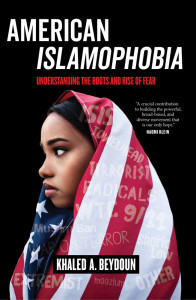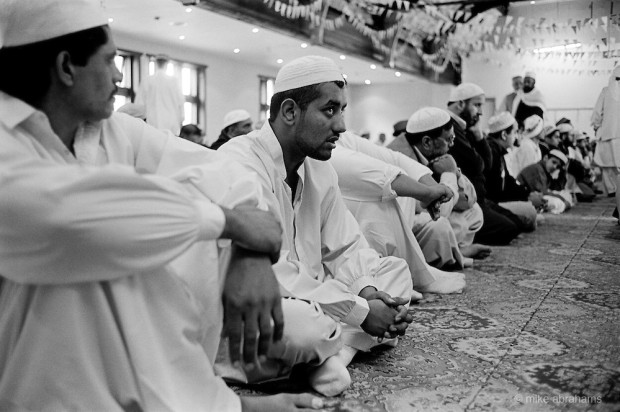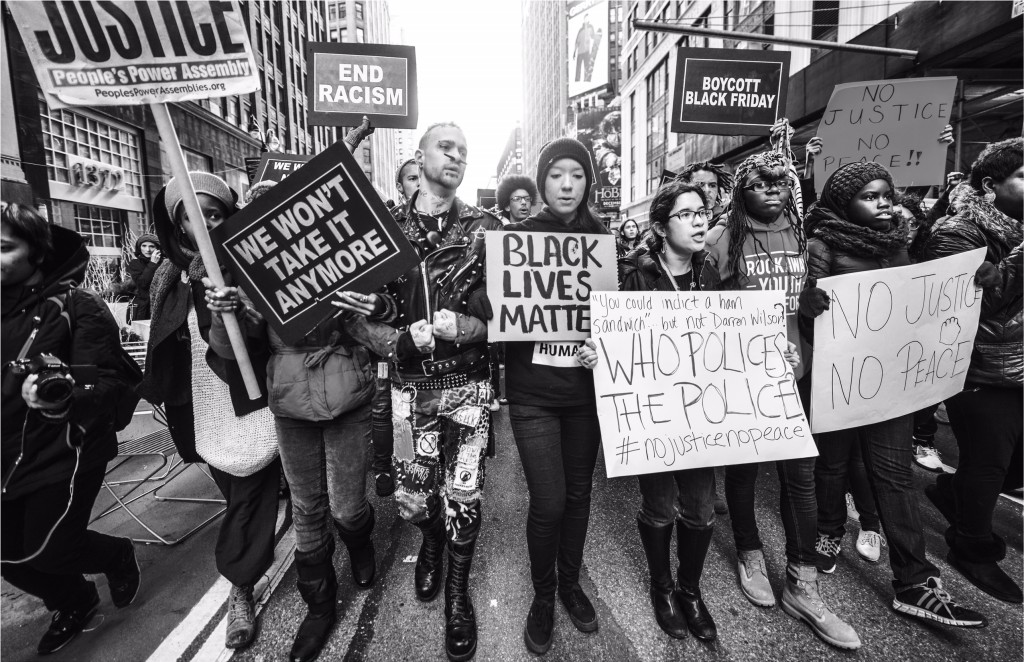“Why is a Black woman on your book cover?” asked the middle-aged, South Asian woman, shortly after I finished lecturing at an event in Michigan. The woman posing the question was a Muslim, as was the young lady featured on the cover of my book, American Islamophobia: Understanding the Roots and Rise of Fear, manifesting a dissonance about how Muslim identity is perceived, and misperceived, beyond and even within Muslim American communities.
 The narrow racial framing of Muslim identity, deeply embedded in the American imagination and still potent today, not only converges with the rising tide of anti-Muslim animus we now understand and know as Islamophobia – but indeed, an integral part of it. Islamophobia in the United States is, in great part, a racial project, spawned by a master discourse that drove European supremacy and today powered by popular views and state policy seeking to safeguard its domestic progeny, white supremacy.
The narrow racial framing of Muslim identity, deeply embedded in the American imagination and still potent today, not only converges with the rising tide of anti-Muslim animus we now understand and know as Islamophobia – but indeed, an integral part of it. Islamophobia in the United States is, in great part, a racial project, spawned by a master discourse that drove European supremacy and today powered by popular views and state policy seeking to safeguard its domestic progeny, white supremacy.
Race and racism are central to any understanding of Islamophobia, as brilliantlyexamined by sociology scholar and author Erik Love, and they configure in myriad ways with the advancement of the aggregate enterprise of Islamophobia in the United States, and beyond its borders. While racism is central, there is more at play – Islamophobia is anchored in an Orientalist underbelly that precedes the creation of the formative American racial enterprise and its modern form, and a protracted War on Terror that extends it through formal law and policy.
Islamophobia is far more than merely “dread or hatred of Muslims,” or “fear or dislike” of the faith and its followers, and these prevailing definitions tend to fixate on explicit or irrational animus, and far too often, the activity of private actors. The role of the state, and its vast network of agencies and agents, and the fluid exchanges and interaction between the state and its polity, is central to understanding Islamophobia.
Islamophobia in the United States is, in great part, a racial project, spawned by a master discourse that drove European supremacy and today powered by popular views and state policy seeking to safeguard its domestic progeny, white supremacy.
Islamophobia is also law, expressly found in its letter and hidden in facially neutral terms intended to discriminate, affixed with the state seals of approval that obliges the polity to adhere to the message that Muslim identity is presumptive of terror threat, and Islam a civilisational foil that must be confronted, or contorted in a form palatable to the state. Approaching a definition and framework for understanding Islamophobia, in all of its complexity, enables an appreciation of its numerous tentacles, and how these tentacles intersect with other forms of racism and bigotry, are extended by law and policy, and reach to colour the perspectives of not only non-Muslims, but also Muslims, and everybody and anybody conditioned by the American Islamophobia that prevails today.
Tracing the history of Islamophobia
In 2015, I embarked on the project of redefining Islamophobia, during a moment when explicit bigotry and hate violence against Muslims in the United States were emboldened by (then candidate and now president) Donald Trump. My search for a new definition, however, was less motivated by contemporary animus, but rather, my examination of “legal Orientalism,” and the centuries’ long position of US civil courts that ruled that Muslim identity was antithetical to whiteness. From 1790 until 1952, American naturalisation law mandated whiteness as a prerequisite for naturalised citizenship, and until the Ex Parte Mohriez decision 1944, Muslims were viewed as a distinct racial group that was not only non-white, but members of a faith held out to be the civilisational antithesis of whiteness.
Muslims were viewed as a distinct racial group that was not only non-white, but members of a faith held out to be the civilisational antithesis of whiteness.
The tropes that drove the formative legal position that Muslims were non-white, and oriented Islam as antithetical to whiteness, were “redeployed” after the 9/11 attacks. That moment that spurred the bleak aftermath that gave rise to Islamophobia as we know it today, spearheaded by the creation of the Department of Homeland Security (DHS) and the initiation of the war on terror. Therefore, the ideas and images, distorted narratives and misrepresentations thrust to the surface after 9/11 that steer Islamophobia today were sowed and legally sealed by Orientalism, which must be understood as the mother of modern Islamophobia. In short, any discussion of Islamophobia must be prefaced by a synopsis Orientalism, and the definitions of the former grounded in its precedent system.
American Orientalism was, in large part, a white supremacist project that collaborated with anti-Blackness and Manifest Destiny to determine whiteness and define citizenship (both formal and substantive), and underneath this all, respond to the underlying existential question: who we are (as Americans), and who we are not? A question that rings at the heart of presidential slogans and immigration policy, a best-selling book by Samuel Huntington and a protracted War on Terror that provides the engine for Islamophobia in America today. Investigating this question, and the myriad actors that seek to answer it by the force of slurs, weapons or policy, steers us towards a more robust understanding of Islamophobia.
A new definition and framework
This historical context, coupled with its modern complexity, inspired my new definition and framing of Islamophobia. Above all, Islamophobia is founded upon the presumption that Islam is inherently violent, alien, and unassimilable – driven by the belief that expressions of Muslim identity correlate with a propensity for terrorism. In addition to this foundational definition are three attendant dimensions: 1- private Islamophobia; 2- structural Islamophobia, and; 3- dialectical Islamophobia.
First, private Islamophobia is the fear, suspicion, and violent targeting of Muslims by private actors. These actors could be individuals or institutions acting in a capacity not directed to the state. Craig Hick’s murder of the three Muslim America students in Chapel Hill, North Carolina in 2015 is a clear example of private Islamophobia, as are arsons on mosques or attacks on visible Muslims. Acts of private Islamophobia, oftentimes driven by caricatured understandings of Muslims and Islam, also menace non-Muslim individuals and institutions thought to be Muslim, such as South Asian Americans or Sikh temples.
Structural Islamophobia, the second dimension, is the fear and suspicion of Muslims on the part of government institutions. This fear and suspicion are manifested and enforced through the enactment of and advancements of laws, policy, programming, or formal pronouncements by state agents. Laws like the US PATRIOT Act or Countering Violent Extremism, the vile anti-Muslim rhetoric of President Trump and the campaigns of state congressmen to pass anti-Sharia legislation distinctly and diversely illustrate structural Islamophobia. Structural Islamophobia has been openly extended by statesman on the Right, including Presidents George W. Bush and Trump, but also democrats like President Barrack Obama, who established counter-radicalisation policing as his signature counterterror policy. Unlike private Islamophobia, structural Islamophobic policy and positions are just as often driven by rational motives as they are irrational, strategically deployed to carry forward specific domestic and international state objectives.
Third, dialectical Islamophobia is the process by which structural Islamophobia shapes, reshapes and endorses views or attitudes about Islam and Muslim subjects. State action legitimises prevailing misconceptions and misrepresentations of Islam and communicates these damaging ideas through state-sponsored policy, programming or rhetoric. Law is not merely policy, but also a set of messages and directives disseminated to broader society, instructing them to partake in the project of policing, punishing and extra-judicially prosecuting Muslims. We see this process functioning most vividly during times of crisis, such as the direct aftermath of a terror attack, when hate incidents and violence towards Muslims and perceived Muslims are pervasive.
Beyond the Cover
This definition enables an understanding of the epistemological and legal roots of American Islamophobia, and its ferocious rise during the past several decades. Just as critically, this framework enables analyses of Islamophobia as it interacts and converges with other systems of stigma and subordination, and indeed, the most ominous among them.
Beyond its popular cover, Islamophobia is everything from law to Hollywood misrepresentations, violent assaults on conspicuous Muslims and innocent bystanders wrongly profiled as Muslims. Islamophobia is all of this, but also far more. It is, above all, a fluidly shifting and intricate system that cannot be reduced to mere “fear or dislike” of Islam and its followers, who occupy a range of distinct stations in society and experience it differently, and for the most vulnerable, disproportionately.
Reckoning with Islamophobia requires situating it within the American context that feeds and foments it, which perils a broad population of could-be victims that manifest the multi-layered diversity of the country they strive to call home – against the collaborative efforts of the state and elements in society that fight to keep Muslims at the margins.
Source: Aljazeera

















No Comments